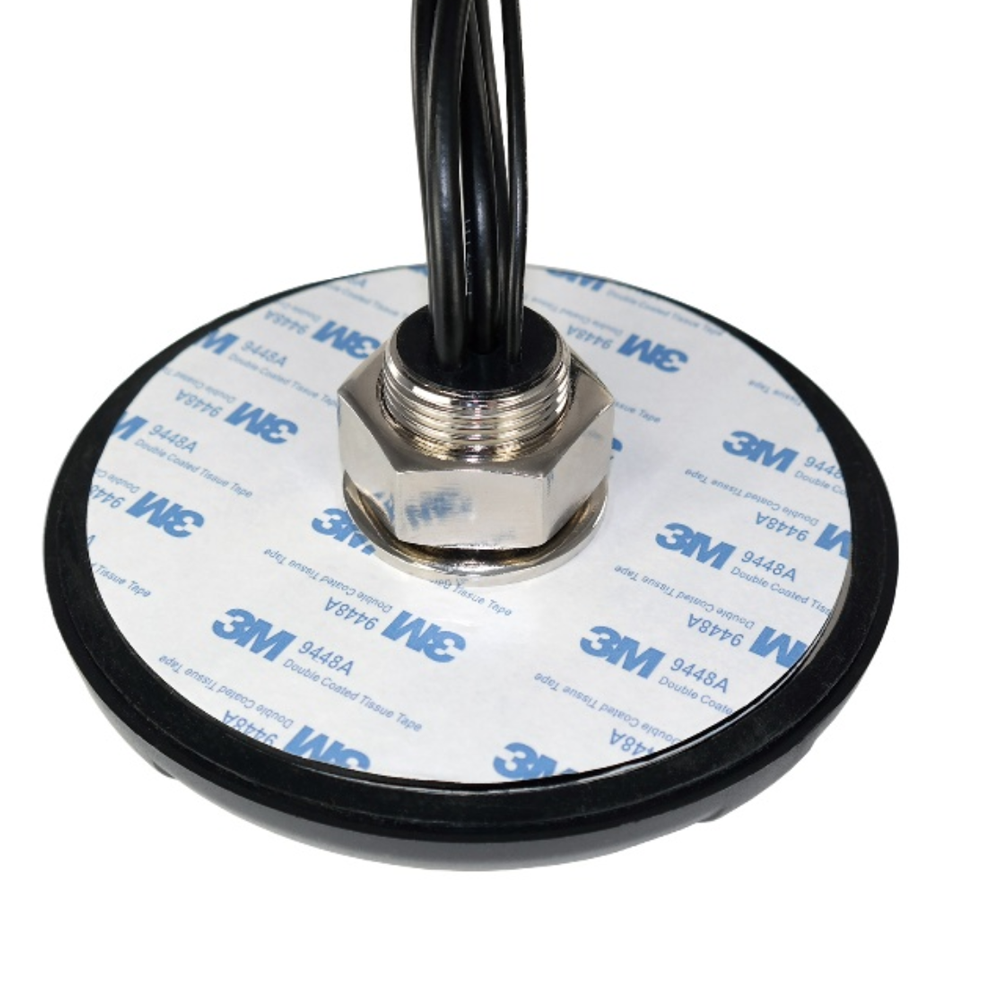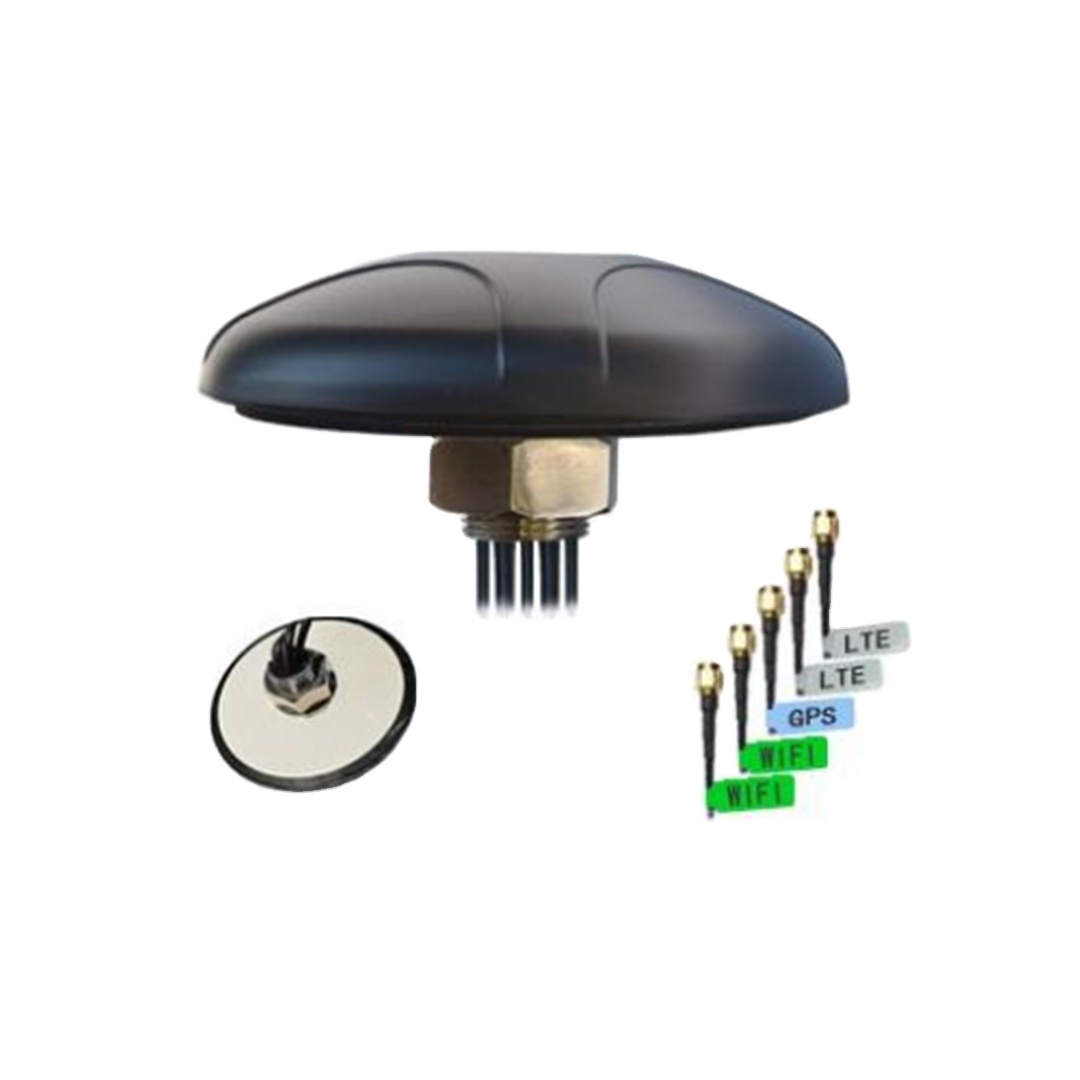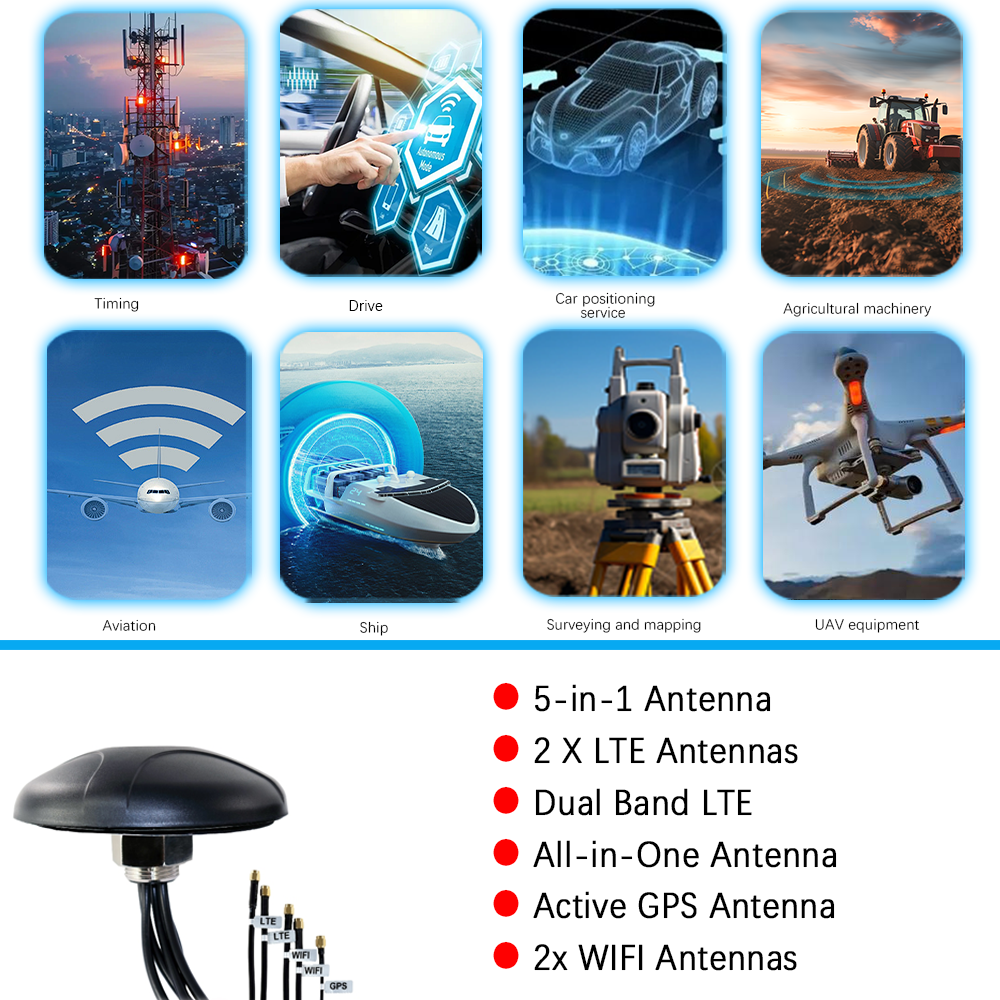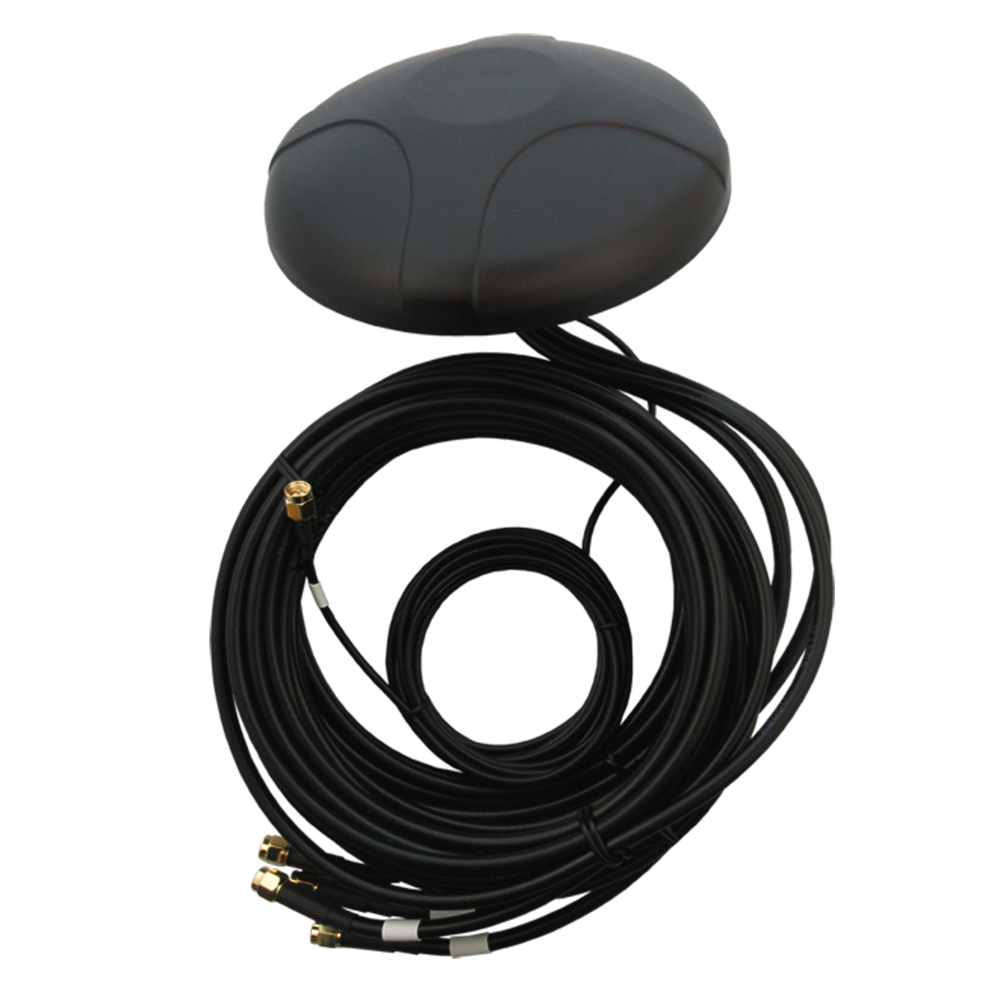The waterproof mushroom GPS antenna is a specialized tool, and its value proposition is defined by a clear set of powerful advantages that make it the only choice for certain applications. However, achieving this performance and ruggedness introduces a corresponding set of challenges and trade-offs that designers and users must acknowledge.
Advantages
Exceptional Environmental Ruggedness and Reliability: This is its paramount advantage. Built to IP67, IP68, or IP69K standards, it is virtually impervious to the elements. It can withstand continuous immersion, high-pressure spray, salt corrosion, UV radiation, and extreme temperature cycles. This ensures uninterrupted operation in the world's harshest environments, from the open ocean to arid deserts and freezing arctic conditions.
Superior Wide-Angle Reception and Stability: The QFH or crossed-dipole design produces a near-hemispherical radiation pattern. This provides consistent gain across the entire sky, not just towards the zenith. This is critical for maintaining a stable signal on rolling and pitching platforms (ships, vehicles, aircraft). It minimizes signal fade and prevents dropouts as the antenna tilts, leading to a more reliable and continuous position solution than a patch antenna could provide in the same dynamic conditions.
Integrated High-Performance LNA: The built-in LNA with low noise figure and high gain is a major system-level advantage. It allows for very long cable runs between the antenna and the receiver without significant signal degradation. This simplifies installation in large vehicles and vessels, as the receiver can be located conveniently in a cabin or bridge without worrying about signal loss. It also preserves the crucial signal-to-noise ratio.
Excellent Multipath Rejection: The combination of a well-designed ground plane and the inherent properties of circular polarization provides good rejection of multipath signals. Multipath, caused by signals reflecting off the ground or other structures, is a primary source of positioning error. The antenna's pattern minimizes sensitivity to low-angle reflections, and the RHCP design helps reject reflected signals, which often become partially left-hand polarized.
Mechanical Durability and Vibration Resistance: The solid metal base, potted electronics, and robust radome make the antenna highly resistant to physical shock and vibration. This is essential for mounting on heavy machinery, construction equipment, off-road vehicles, and ships that experience constant pounding from waves.
Ease of Installation and Mounting: The standard form factor is designed for easy mounting on a flat surface using a single hole. Standard connectors (TNC, SMA) and pre-attached cables make the final connection simple and reliable.
Challenges and Limitations
Size and Profile: The mushroom antenna is significantly larger and has a higher profile than a low-profile patch antenna. This can create aerodynamic drag on vehicles, be susceptible to damage from low-hanging obstacles like tree branches or garage doors, and simply be too obtrusive for applications where a discreet form factor is desired.
Cost: The use of high-grade materials (marine-grade stainless steel, high-quality coaxial cable), the complex internal radiating structure, the addition of the LNA, and the rigorous sealing and potting processes make these antennas considerably more expensive than consumer-grade passive patch antennas.
Power Requirement: As an active antenna, it requires a DC power source to operate the internal LNA. This power is almost always supplied from the GPS receiver through the coaxial cable via a bias-T circuit. This adds complexity to the system and means that a faulty antenna or cable can potentially draw excess current and damage the receiver's power circuit.
Weight: The metal base and potting material give the antenna substantial weight. This must be considered for mounting on thin-gauge metal surfaces (like a car roof) or on composite structures, where reinforcing may be needed to prevent flexing or damage.
Limited Ground Plane Flexibility: Unlike a patch antenna whose performance is heavily dependent on the ground plane it's mounted on, the mushroom antenna has its own integrated ground plane. This is an advantage for consistent performance but means it cannot be easily integrated into a custom ground plane system for specialized applications.
Potential for GNSS Jamming Vulnerability: While excellent at receiving weak satellite signals, the high-gain LNA can also amplify strong, unwanted interference or jamming signals. In militarily or commercially sensitive areas, this can make the system more vulnerable to being blinded by jammers compared to a system with less front-end gain. Some advanced models include built-in filters to mitigate this.
In conclusion, the advantages of the waterproof mushroom antenna are overwhelmingly focused on reliability and performance in dynamic and harsh environments. The challenges are primarily related to its physical size, cost, and system complexity. For applications where failure due to environmental factors is unacceptable, these challenges are a small price to pay for unwavering performance.
Series 5: Applications and Future Trends of the Waterproof Mushroom GPS Antenna
The waterproof mushroom GPS antenna is not a general-purpose component; it is a specialized solution deployed in fields where operational success and safety depend on continuous and reliable positioning data, regardless of external conditions. Its applications are a direct reflection of its rugged design and superior performance characteristics. As technology evolves, its role is also adapting to new challenges and opportunities.
Applications
Marine Navigation: This is the classic and most widespread application. Every type of vessel, from small recreational sailboats and fishing boats to massive container ships and naval vessels, relies on these antennas. They are mounted on the radar arch, mast, or wheelhouse roof to provide uninterrupted GPS data for chart plotters, autopilots, and AIS transponders. Their resistance to saltwater corrosion and ability to maintain lock while heeling and pitching are indispensable for safety at sea.
Precision Agriculture: Modern farming equipment is highly automated. Tractors, combines, and sprayers use GPS for guidance, automated steering, and variable rate application of seeds and chemicals. These machines operate in incredibly dusty conditions and are frequently cleaned with high-pressure washers. The waterproof mushroom antenna is one of the few types that can survive this abuse while providing the reliable signal needed for sub-meter accuracy when used with RTK or PPP corrections.
Construction, Mining, and Heavy Equipment: Bulldozers, excavators, graders, and mining trucks use GPS for machine control, grade checking, and fleet management. The operating environment is characterized by extreme vibration, dust, mud, and the risk of physical impact. The ruggedized construction of the mushroom antenna ensures that positioning data—critical for moving the right amount of earth to the correct design specifications—is always available.
Transportation and Logistics: Long-haul trucks, buses, and fleet vehicles use them for tracking, navigation, and compliance monitoring. Mounted on the roof, they are exposed to sun, rain, snow, ice, and car wash tunnels. Their reliability ensures that fleet managers have accurate data on vehicle location and status.
Public Safety and Military: Police, fire, ambulance, and military vehicles require dependable navigation in all terrains and weather conditions. The antenna's durability and performance under stress make it suitable for these critical missions. Military versions may include additional features like encrypted GPS reception (SAASM) or enhanced resistance to jamming and spoofing.
Autonomous and Robotic Systems: As autonomous solutions move into agriculture, mining, and logistics, the need for robust, high-integrity positioning sensors grows. Autonomous tractors and haul trucks use these antennas as a primary source of absolute position, feeding data into the vehicle's control system. Their stability is key to safe operation.
Future Trends
The future of the waterproof mushroom antenna is one of evolution and increased integration, not obsolescence.
Multi-Band and Multi-Constellation Support: The next generation of antennas is evolving beyond GPS L1. New designs are incorporating stacked or more complex radiating elements to receive signals from all constellations (GPS, GLONASS, Galileo, BeiDou) and on multiple frequencies (L1, L2, L5). This provides faster convergence, higher accuracy, and better robustness through signal redundancy. Designing a wideband QFH or dipole that covers from 1150 MHz (L5) to 1600 MHz (L1) is a significant engineering challenge that is being actively addressed.
Integration of Advanced Filtering and Anti-Jamming (AJ): The threat of GNSS jamming and spoofing is growing. Future antennas will increasingly incorporate built-in filtering technology, such as Bandpass Filters to reject out-of-band interference and even adaptive nulling techniques to suppress in-band jammers. This turns the antenna from a simple receiver into an intelligent first line of defense for positioning systems.
Enhanced Materials and Lightweighting: Research into advanced composite materials for radomes and bases will continue, aiming to reduce weight and cost without compromising durability or RF performance. New potting compounds with better thermal conductivity and lower dielectric loss will also improve reliability and performance.
Tighter Coupling with Inertial Navigation Systems (INS): The antenna will be increasingly sold as part of a integrated positioning module that includes an inertial measurement unit (IMU). The antenna provides the absolute position reference, while the IMU provides high-rate velocity and attitude data. The two are fused together to provide a continuous, smooth, and accurate position solution even during short GNSS outages caused by tunnels, foliage, or urban canyons.
The Rise of "Smart" or Connected Antennas: Future antennas may include built-in diagnostics to monitor their own health—reporting parameters like internal temperature, moisture detection, or amplifier status back to the receiver. This enables predictive maintenance, alerting users to potential failures before they occur.
Standardization for Autonomous Vehicles: As the autonomous vehicle industry matures, standards will emerge for the performance and testing of key components like GNSS antennas. The mushroom antenna form factor, with its proven reliability, is well-positioned to be a benchmark in these standards for non-passenger vehicle applications like robo-taxis and autonomous trucks.
The waterproof mushroom GPS antenna will remain a vital component in the industrial and marine sectors for the foreseeable future. Its evolution will be marked by greater intelligence, broader frequency coverage, and even tighter integration with other sensors, ensuring it continues to provide the bedrock of reliable positioning for the world's most critical mobile assets.
Conclusion
The waterproof mushroom GPS antenna stands as a formidable testament to the principle that form must follow function, and that reliability is a feature that must be engineered from the ground up. It is a component that embodies a specific and uncompromising philosophy: that the acquisition of a satellite signal is so critical that the means of acquisition must be protected with the same vigor as the most vital machinery. It is not designed to be the smallest, the cheapest, or the most discreet antenna; it is designed to be the most dependable.
Its design is a masterclass in holistic engineering. The choice of a quadrifilar helix or crossed-dipole radiating structure is a deliberate selection for wide-angle, stable coverage, prioritizing consistent performance across the entire sky over peak gain in a single direction. The integration of a low-noise amplifier is a recognition of real-world installation challenges, ensuring that signal integrity is preserved over the long cable runs necessary in vehicles and vessels. And every other aspect of its construction—the marine-grade metals, the UV-stabilized radome, the precision O-rings, and the rugged potting compound—is a direct response to the environmental threats that would swiftly disable a lesser component.
The analysis of its advantages and challenges reveals its true nature: it is a tool for professionals. Its value is measured not in a laboratory under ideal conditions, but on a rolling deck in a force 9 gale, on a tractor engulfed in dust, or on a bulldozer vibrating across a construction site. Its advantages are all focused on overcoming these real-world adversities. Its challenges—its size, cost, and complexity—are simply the non-negotiable price of admission for this level of ruggedized performance.
Its applications paint a picture of the critical infrastructure of the modern world: global shipping, food production, construction, and national security. In these fields, a loss of position data is not an inconvenience; it can represent a risk to safety, a significant financial loss, or a project delay measured in days. The mushroom antenna is the guarantor against this loss.
As we look to the future, the antenna will not stand still. It will evolve to embrace new signals, integrate smarter electronics, and defend against new threats like jamming. But its core mission will remain unchanged. It will continue to be the unflinching, ruggedized guardian of the GNSS signal, a robust mushroom-shaped beacon on the rooftops of the world's essential machinery, ensuring that no matter the conditions, they always know exactly where they are.




































































 Language
Language
 En
En Cn
Cn Korean
Korean

 Home >
Home > 








 18665803017 (Macro)
18665803017 (Macro)













